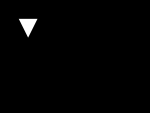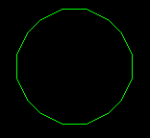love.graphics.polygon
| Available since LÖVE 0.4.0 |
| This function is not supported in earlier versions. |
Draw a polygon.
Following the mode argument, this function can accept multiple numeric arguments or a single table of numeric arguments. In either case the arguments are interpreted as alternating x and y coordinates of the polygon's vertices.

|
When in fill mode, the polygon must be convex and simple or rendering artifacts may occur. love.math.triangulate and love.math.isConvex can be used in 0.9.0+. |
Function
Synopsis
love.graphics.polygon( mode, ... )
Arguments
Returns
Nothing.
Function
Synopsis
love.graphics.polygon( mode, vertices )
Arguments
Returns
Nothing.
Examples
Two ways of drawing the same triangle
This example shows how to give the coordinates explicitly and how to pass a table argument.
-- Giving the coordinates directly.
love.graphics.polygon("fill", 100,100, 200,100, 150,200)
-- Defining a table with the coordinates.
-- This table could be built incrementally too.
local vertices = {100,100, 200,100, 150,200}
-- Passing the table to the function as a second argument.
love.graphics.polygon("fill", vertices)
Draw concave polygon
local vertices = {100,100, 200,100, 200,200, 300,200, 300,300, 100,300} -- Concave "L" shape.
local triangles = love.math.triangulate(vertices)
for i, triangle in ipairs(triangles) do
love.graphics.polygon("fill", triangle)
end
Draw rotated rectangle
This is one way to draw a rotated rectangle.
function drawRotatedRectangle(mode, x, y, width, height, angle)
local cosa, sina = math.cos(angle), math.sin(angle)
local dx1, dy1 = width*cosa, width*sina
local dx2, dy2 = -height*sina, height*cosa
local px1, py1 = x, y
local px2, py2 = x+dx1, y+dy1
local px3, py3 = x+dx1+dx2, y+dy1+dy2
local px4, py4 = x+dx2, y+dy2
love.graphics.polygon(mode, px1,py1, px2,py2, px3,py3, px4,py4)
end
Draw rotated boid (directed triangle)
function drawBoid (mode, x, y, length, width , angle) -- position, length, width and angle
love.graphics.push()
love.graphics.translate(x, y)
love.graphics.rotate( angle )
love.graphics.polygon(mode, -length/2, -width /2, -length/2, width /2, length/2, 0)
love.graphics.pop()
end
x, y, angle = 200, 100, math.pi/4
drawBoid ("fill", x, y, 20, 10 , angle)
Pixel-perfect Hexadecagon
For better result it can be used with "rough" line style and "nearest" canvas filter.
function hexadecagon (mode, x, y, radius) -- same as love.graphics.circle
local w1 = math.atan(2/5) -- ratio of two integers, 21.8 degrees
local w2 = math.atan(5/5) -- ratio of two integers, 45 degrees
local k1 = (w1+w2)/2
local k2 = math.cos((w2-w1)/2)
local a = radius
local b = radius*math.tan (w1 / 2)
local c = radius*math.cos (k1) / k2
local d = radius*math.sin (k1) / k2
local vertices = {
a, b, c, d, d, c, b, a,
-b, a, -d, c, -c, d, -a, b,
-a,-b, -c,-d, -d,-c, -b,-a,
b,-a, d,-c, c,-d, a,-b}
love.graphics.translate (x+0.5, y+0.5)
love.graphics.polygon (mode, vertices)
love.graphics.translate (-x-0.5, -y-0.5)
end
canvas = love.graphics.newCanvas(width, height)
canvas:setFilter("nearest", "nearest")
love.graphics.setLineStyle("rough")
love.graphics.setCanvas (canvas)
love.graphics.setColor (0,1,0)
hexadecagon ("line", 200, 100, 60)
love.graphics.setCanvas ()
function love.draw()
love.graphics.setColor (1,1,1)
love.graphics.draw (canvas)
end
See Also
Other Languages
Dansk –
Deutsch –
English –
Español –
Français –
Indonesia –
Italiano –
Lietuviškai –
Magyar –
Nederlands –
Polski –
Português –
Română –
Slovenský –
Suomi –
Svenska –
Türkçe –
Česky –
Ελληνικά –
Български –
Русский –
Српски –
Українська –
עברית –
ไทย –
日本語 –
正體中文 –
简体中文 –
Tiếng Việt –
한국어
More info


